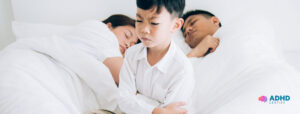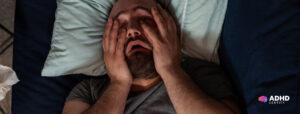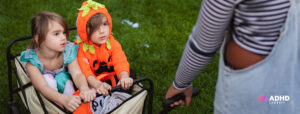It’s a familiar night at home, your child with ADHD begs for “one more story,” fidgets under the covers, and hours later still isn’t asleep. You wonder if it’s poor routine or something deeper. The truth is, the ADHD brain runs on a delayed clock, making it harder to switch off and rest.
According to the NHS and NIHRfunded Southampton study, up to three quarters of children with ADHD struggle with ongoing sleep issues, a pattern that fuels fatigue, distractibility, and emotional swings the next day.
One parent described it best: their seven year old “nighttime ninja” sneaks up at 2 a.m. to hunt for hidden devices and streams YouTube videos or Disney+ shows until sunrise. It’s a scene many families recognise, and one rooted not in defiance, but in how ADHD affects children’s sleep wake rhythm.
Next, let’s explore why that rhythm runs late and how it shapes children’s rest.
The Science Behind ADHD Sleep Problems in Children
From body clocks to brain chemistry, several scientific factors explain why so many children with ADHD struggle to sleep well. Let’s look at how these systems interact to affect rest.
Delayed Sleep Wake Rhythm
Children with ADHD often have a delayed sleep phase pattern, where the brain stays alert late into the night. This is described in clinical guidance for neurodivergent children from Bedfordshire and Luton Children’s Health NHS, which highlights that stress and circadian misalignment play major roles in ADHD sleep disturbance.
Brain Chemistry and Arousal
ADHD alters neurotransmitters like dopamine and norepinephrine that control both attention and alertness. These same brain chemicals help transition the body from wakefulness to sleep. When levels are unbalanced, the brain struggles to “switch off,” causing racing thoughts and restlessness. This neurochemical link is noted in Derbyshire Healthcare NHS Sleep Advice, which explains that ADHD brains often remain in a state of heightened arousal after bedtime.
Emotional and Cognitive Overload
The emotional regulation difficulties common in ADHD make winding down harder. The Solihull Council ADHD Parent-Carer Booklet emphasises that bedtime routines and consistent cues reduce anxiety and improve the natural body clock in children with ADHD, showing how essential stress reduction is to restful sleep.
The Cycle: How Poor Sleep Worsens ADHD Symptoms
Sleep and ADHD symptoms sustain a two-way relationship: poor sleep worsens behaviour and emotional control, while ADHD itself disrupts sleep signals.
| Poor Sleep Factor | Next Day ADHD Impact |
| Restless nights | Irritability and frustration |
| Late sleep onset | Difficulty concentrating in school |
| Frequent waking | Forgetfulness and disorganisation |
| Short sleep duration | Emotional regulation issues |
The Sleep Foundation explains this cycle clearly: insufficient sleep increases impulsivity, attention lapses, and hyperactivity.
Many families describe this as “ADHD burnout,” where exhaustion undermines motivation and mood. Breaking this loop starts by identifying the triggers behind bedtime resistance.
Triggers and Everyday Sleep Barriers
Insomnia in children with ADHD usually arises from a mix of behavioural, sensory, and medical factors. Understanding each helps families take effective action.
Behavioural Triggers
Evening hyperfocus is common, a child deeply engaged in play or screens loses track of time. The stimulation from blue light also delays natural melatonin release. UK sleep charities such as The Sleep Charity note that dopamine seeking behaviour (like scrolling or gaming) can keep an ADHD child’s brain active long past bedtime.
Environmental Factors
Children with ADHD often have sensory sensitivities. Rooms that are noisy, cluttered, or too bright make it harder to settle. A dark, quiet environment signals the brain that it is time to rest. Using devices such as white noise machines or nightlights can help with sensory regulation.
Medication Timing
Stimulant medication can delay sleep onset if doses are too late in the day. NICE clinical guidance NG87 and NHS paediatric services note that dose timing or formulation may need review if insomnia persists, always in consultation with clinicians.
Co-existing Sleep Disorders
Conditions like sleep apnoea and restless legs syndrome can overlap with ADHD and amplify sleep disruption. The Evelina London NHS sleep-and-exercise guide notes that neurodevelopmental conditions frequently coexist with complex sleep disorders, highlighting the need for specialist screening.
Signs to watch: restless movement, snoring, or frequent waking.
When to seek advice: more than three disturbed nights weekly over three months.
Practical Strategies That Help Families
Here’s how to use evidence based tactics to help children with ADHD sleep better. Each approach aligns with NHS and NICE recommendations.
1. Build a Predictable Routine
Set a consistent bedtime and wake-up time daily. Visual schedules work well for younger kids. The Solihull Council’s ADHD Parent-Carer Booklet stresses that regular patterns help the body clock regulate naturally.
Why it helps: Consistency strengthens circadian rhythm alignment.
2. Create a Calming Environment
Dim lights, reduce noise, and avoid screens one hour before bed. NHS linked guidance from Derbyshire Healthcare recommends cool, dark bedrooms to boost melatonin production.
Why it helps: Lower light exposure and sensory calmness cue sleep readiness.
3. Encourage Wind Down Activities
Swap stimulation for calming pre-bed routines. Family reading, mindful breathing, or listening to gentle music lowers anxiety.
Why it helps: Reduces stress hormones and establishes predictable “cue to calm.”
4. Manage Nutrition and Timing
Avoid caffeine and sugary snacks after afternoon hours. Offer balanced, small bedtime snacks if hungry.
Why it helps: Keeps energy stable overnight and reduces arousal.
5. Melatonin and Professional Guidance
The NICE ADHD guideline (NG87) acknowledges melatonin as a possible intervention for children with chronic sleep onset insomnia, prescribed only under medical supervision.
Why it helps: Assists the natural night-time hormone cycle when used appropriately.
6. ADHD Friendly Sleep Cues
Use timers or phone alerts as visual and auditory prompts for getting ready for bed. Introduce a nightly “digital sunset” rule; all devices off one hour before lights out.
Why it helps: Predictable cues reinforce body clock regularity and restore sleep association pathways.
When Professional Support Is Needed
Even with healthy routines, some ADHD related sleep issues persist. If your child struggles to fall or stay asleep at least three nights a week for more than three months, seek medical review.
Start with a GP for assessment or referral.
The University Hospital Southampton digital sleep study and other NHS research show that clinical and behavioural programmes can significantly improve sleep and daytime attention. Many NHS trusts (for example, Derbyshire Healthcare NHS Foundation Trust) incorporate sleep review into ADHD care plans. Parents can also use sleep diaries to document bedtimes, wake times, and disturbances, valuable tools for paediatric teams to personalise support.
With the right combination of behavioural strategies and specialist advice, most children show real improvement in both rest and focus within weeks.
Conclusion: Helping ADHD Children Sleep Better
Sleep problems in ADHD are common but treatable. The underlying challenges are biological, not behavioural, and respond best to structure, gentle consistency, and informed care. Regular routines, calming bedtime habits, and targeted guidance can transform restless nights into steady, restorative sleep.
For families needing tailored help, our Children’s ADHD Assessment provides access to clinical evaluation and advice aligned with NHS standards. Combining professional insight with home adjustments ensures children gain the rest they need to thrive at school and beyond.
A calmer evening really can start tonight, by turning down the lights, turning off screens, and using gentle cues that guide children with ADHD toward better sleep and stronger daily focus.




